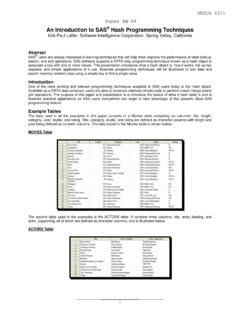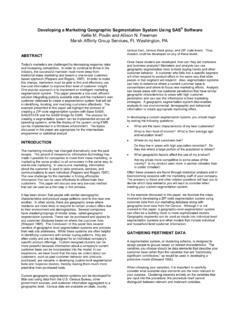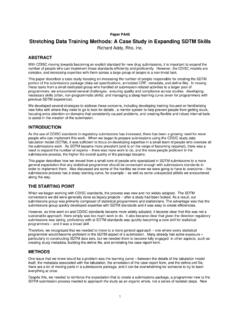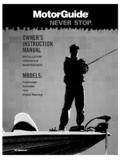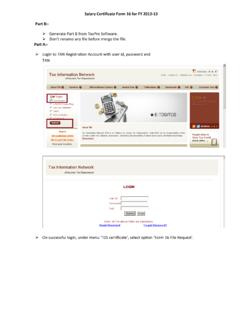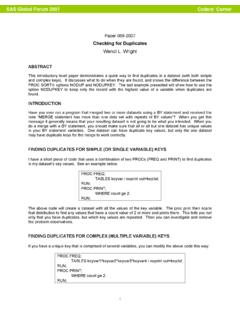Transcription of Point, Set, Match (Merge) – A Beginner’s Lesson
1 Point, Set, Match ( merge ) a beginner s LessonJennifer Hoff Lindquist, Institute for Clinical and Epidemiologic Research,Veterans Affairs Medical Center, Durham, NCThe phrase Point, Set and Match is used in tennis when the final game winning point is scored. Those terms are also specialSAS techniques that can make you a champion SAS programmer. Projects can collect data from a number of differentsources. Combining the information into a cohesive data structure is essential for resource utilization. One of the mostvaluable resources is your time. By combining and collapsing data into a small number of datasets, information can beaccessed and retrieved more quickly and already properly linked. Two techniques used with manipulating existing data setsare SET and SET statement is often used in two ways copying and CopyTo avoid corrupting a permanent SAS data set, copy of the data set is desirable. Suppose the permanent SAS A consists of 5 observation with 4 variables.
2 The syntax to create a copy of the data set is Set <dataset name>.SAS Code: Data White; Set ;Run;The contents of the White data set are an exact replicate of the orignal A data data setIDGRPAGEELIG1A 30Y2A 40N3A 50N4A 60Y5A 70 Set AppendThe SET statement can be used to append or stack data data set Yellow consist of 3 observations with 3 variablesYellow Data SetIDGRPELIG3B Yes5B No6B YesSAS code: Data TwoSets; Set White Yellow; Run;Any number of data sets could be listed. The white data set contributes 5 observations and the yellow data set tacks on 3observations. All the variables in the two data sets are included. If any variables are only in one of the data sets, the variableis included in the concatenated dataset. The observations which originated from a dataset without a particular variable has thevariable added to the observation with a missing Output:IDGRPAGEELIG1A 30Y2A 40N3A 50N4A 60Y5A 703B.
3 Yes5B . No6B . YesThe observations are simply stacked starting with the data set listed first. SAS then continues tacking on the observations tothe bottom of the list for each data set listed in the SET statement. This is especially useful when consolidating data setswith mutually exclusive records but the same records side by side instead of stacking is another data consolidation technique. Many times your want to create adata set with one observation per patient/person. A merge statement then is more applicable. The remainder of the paper willbe devoted to discussing the various types of merges One to One merge , Match merge , One to Many merge and Many toMany TO ONE MERGEThe first type of merge is a one to one merge . The accidental or careless use of this merge can produce disastrous results. Inall SAS merges a data set listed first (on the left) is overwritten by the corresponding data in the data set on the right.
4 In a oneto one merge the observations are conjoined by their relative positions-the first observation with the first observation, Data SetYellow Data SetIDGRPAGEELIGIDGRPELIG1A 30 Y 3 BYes2A 40 N 5 BNo3A 50 N 6 BYes4A 60 Y5A 70 SAS CodeData MergeSet; merge White Yellow;Run;In this one to one merge , the values in the first three observations in the white data set are wiped out by the overlappingvariables in the yellow data set even though they are NOT referring to the same OutputIDGRPAGEELIG3B 30 Yes5B 40No6B 50 Yes4A 60Y5A 70 The resulting data set has lost patients with ids 1 and 2. The age for patient #3 appears to be 30 when it is actually the agefor patient #1. Other errors include the ages for patients 5 and 6. Patient #5 has ages 30 years apart! Due to this potential tolose/corrupt data, the one to one merge is best - Match MERGEA refinement of the one to one merge is the Match merge .
5 Using the BY statement, variables are listed which SAS uses tomatch observations. Data sets must be sorted on the same variables as listed in the Match merge BY statement. More thantwo data sets may be included in the merge statement. More than one variable can be listed on the BY statement. But onlyone BY statement is allowed for each merge Code:Proc Sort data=white; By Id;Proc sort data=yellow; By Id;Run;Data Mergeby; merge white Yellow; By ID;Run;SAS OutputIDGRPAGEELIG1A 30Y2A 40N3B 50 Yes4A 60Y5B 70No6 BYesIf two data sets have variables with the same name, the value of the variable in the data set named last will overwrite the valueof the variable in the data set name previously. The ELIG for Patient #3 in the white date set was N but in the yellow data setELIG was Yes . Since the order in the merge statement was white then yellow the value in the yellow data set appears in themerged dataset.
6 However, due to the overwrite property this conflict of eligibility status is Match merge and the one to one merge differ in syntax only in the use of the BY statement. It is (too) easy toinadvertently leave off the BY statement. Results are NOT the same! SAS has acknowledged that this can be a problem. Inversion 8, there is a system option called MERGENOBY. It has 3 settings None, Warning, Error. The Warning setting willwrite a Warning message in the log whenever a merge is performed without a BY statement but will continue processing. TheError setting will write an Error message in the log and halt processing. The None setting no message is written in the log. Istrongly recommend using at least the Warning -IN OptionA useful option with both the SET and merge statements is the IN statement. The syntax is data set name (IN= temporaryvariable). The temporary variable is assigned a one if the observation came from that data set.
7 The temporary variable isreceives a value of zero if the observation is not in that data set. The temporary variable exists only for the length of time ittakes to process the observation. It is not accessible after the completion of the data step. If the information will be neededlater, a regular variable can copy the value of the temporary variable;SAS Code:Data MergeSource; merge White (IN=InWt) Yellow(IN=InYel); By Id;If InWt=1 and InYel=1;*Alternate if InWt=InYel;WtFileInd=InWt;Run;An intermediate internal processing snapshot shows the values of the temporary 30 Y102A 40 N103A50N113 BYes4A 60 Y105A 70115B No016 BYesDue to the subsetting if statement the observation must be in both the white and the yellow data sets to make the eligibilityrequirements for the MergeSource data set. The temporary variables InWt and InYel are not in the resulting data set. Theproblem remains with the second data set overwriting the first Data setIDGRPAGEELIGWtFileInd3B50 Yes15B70No1 merge - RENAME OptionAn option to avoid some of the overwrite problems is to rename the variables in the merge .
8 The syntax is after the datasetname (rename=(old variable=new variable))SAS CodeData MergeRen; merge White(rename=(ELIG=WELIG)) Yellow(rename=(ELIG=YELIG)); By ID;Run;The original data set supplies the value to the new variable as long as it was the dataset contributing the OutputIDGRPAGEWELIGYELIG1A 30Y2A 40N3B50 NYes4A 60Y5B 70No6 BYesBy using the rename option, it is possible to detect the inconsistency in patient #3 - ONE TO MANY merge or MANY TO ONE MERGEA third major category of merges is the One to Many and the closely related Many to One merges. The syntax is the same asthe matched merge . However, it is important to know which data set has the many observations and which data set has the one observation. The order the data sets are listed in the merge statement makes a difference. The logistics of the mergeis basically the same. The items in the right data set overwrites the data in the left data Code:Data One2 Many; merge white green; By id;Run;Visualizing the data sets side by side will help show what Data SetGreen Data SetIDGRPAGEELIGIDGRPTYPE1A 30 F2A 40 M3A 50 M3C a3Cb3Cc4A 60 F5A 705C b5 CcResults of a One to Many MergeIDGRPAGEELIGTYPE1A30 Y2A40 N3C50 Na3C50b3C50c4A60 Y5C70b5C70cThe values in variables AGE and ELIG are retained until the value of the BY GRP variable the order is reverse, a Many to One merge results in a different data Code:Data Many2 One; merge green white; By id;Run;Looking at the data sets side by side, recall the data on the right overwrites the data on the Data SetWhite Data SetIDGRPTYPEIDGRPAGEELIG1A 30 Y2A 40 N3C a3A 50 N3C b3C c4A 60 Y5C b5A 705C cThe results of the Many to One MergeIDGRPTYPEAGEELIG1A30 Y2A40 N3Aa50N3Cb.
9 3Cc .4A60 Y5Ab705Cc .A Many to One merge is possible. However, the values of AGE and ELIG were not retained. The Many to One and the Oneto Many data sets are different. The differences are of a One to Many MergeIDGRPAGEELIGTYPE1A30 Y2A40 N3C50Na3C50b3C50c4A60 Y5C70b5C70cBe aware the simple change in the order the data sets are listed DOES make a is import to know your data. Look at the proc contents before performing merges. Print several observations of the originaldata sets and the merged dataset. Check and make sure you are getting the results you - MANY to MANY merge - GeneralThe last category is a Many to Many merge . This type of merge prompts regularly recurring questions on SAS-L, a mail servelist for SAS questions. The problem is the same basic syntax does not yield the desired results for a Many to Many situation!Green Data SetRed Data SetIDGRPTypeIDCAT3C a3103C b3205C c5505C b5605C dThe usual DESIRED results are a Cartesian cross product with 10 a 103C b 103C c103C a 203C b 203C c205C b 505C c505C b 605C c60 However, the expected SAS code does NOT produce the above Code:Data Many2 ManyERROR; merge red green;By Id;Run;ResultsIDGRPTYPECAT3C a103C b203C c205C b505C c60 Possible Solutions include using a SQL procedure or manipulate the dataset with the POINT MANY to MANY USING SQLThe SQL procedure implements the Structured Query Language.
10 Using proc SQL a Cartesian cross product data set can Code:Proc SQL;Create table manySQL asSelect *From green, redWhere ;Quit;Explanation of SQL codeThe phrase Create table many SQL as creates a data set named manySQL, storing the results of the query code Select * includes all the variables all of the data sets listed in the next snippet of code. An alternative is to namethe variables you want to keep in the data names of the source data sets are identified with From green,red .The instructions Where states the in a MANY to MANY MERGEI nstead of using Proc SQL, it is possible to create the data set in a data step. This is accomplished through accessingobservations in one data set sequentially and the observations in the other directly using the POINT= vast majority of my work I process data sequentially. That is accessing the observations in the order in which they appearin the physical file. Usually every observation needs to be examined, and processed so sequential access is adequate.
